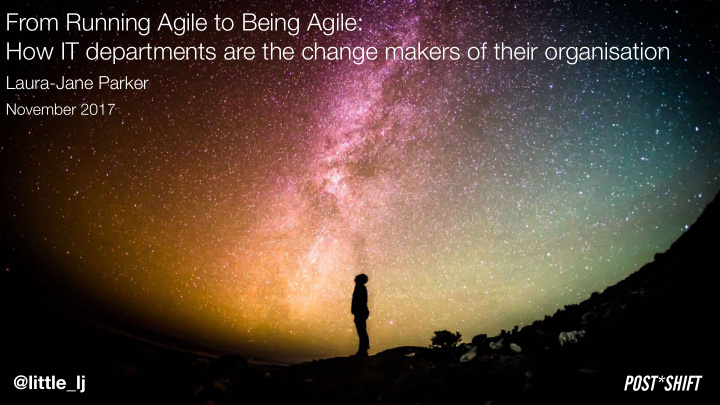



From Running Agile to Being Agile: How IT departments are the change makers of their organisation Laura-Jane Parker November 2017 POST*SHIFT @little_lj
POST*SHIFT
In agile we trust?
It’s certainly captured the attention of the C-Suite 2017 Key Priorities CIOs Enabling enterprise agility Infrastructure & Operations Managing change CMOs Leading culture change and transformation Customer experience Transforming to a customer- centric culture CDOs Nurturing a digital culture
What does agile really mean?
An agile programme? Cartoon by Geek & Poke
Stand-ups and kanban boards? Photo by Patrick Perkins on Unsplash
How much of it is agile theatre? Photo by Lloyd Dirks on Unsplash
Agile sounds simple…until you dig in… We want organisations that are… adaptive & emergent flexible agile & iterative customer-centric open Innovative servant lead collaborative connected … the list goes on…
But actually… “Doing agile is a set of ac � vi � es, but being agile is the state of mind, the ongoing capability, and the cultural adaptability” - Pearl Zhu, Digital Agility: The Rocky Road from Doing Agile to Being Agile
From Doing Agile -> Being Agile or: From Agile Projects -> Agile Org
There are some great examples out there of true organisational agility Lets start with FAVI Favi’s guiding principles put trust in the associates and empower those closest to the customer. Three key principles are: People are systematically considered to be good (reliable, self-motivated, trustworthy, intelligent) There is no performance without happiness (to be happy, we need to be motivated. To be motivated, we need to be responsible. To be responsible, we must understand why and for whom we work, to be free to decide how) Value is created on the shop floor (shop floor operators craft the products; the CEO and sta ff at the best serve to support them, at worst are costly distractions)
There are some great examples out there of true organisational agility And next, Spotify Spotify uses an organisational structure designed to distribute authority to those closest to the information, made up of: Squads - operate as a mini-start-up, a self-organising team responsible for one specific mission aligned to UX Tribes - a collection of squads working in related areas; seen as the ‘incubator’ to the squads. Chapters - a group of people with similar skills and competencies within the same tribe Guilds - communities of interest across the organisation
And many others to choose from
Barriers & Pain Points
Primary Research Conducted Last Year…
Plus experience from the front-line In large scale agility experiments, we consistently see the same pain points coming back: interface between agile & lean culture learning curve for ways of working employees working agile, whilst leadership is waterfall staffing agile teams moving back & forth between agile teams and the line org or resource pool
And of course, there are always those…
Why we see these change programmes fail more than they succeed
Change programmes are like crash diets Photo by Craig Sunter
Seriously, is this another change programme? Photo Credit
What if, instead, we looked to the quantified self movement for inspiration 22
We need to change change
There is no perfect ‘target operating model’ end-point Photo by jayneandd
We must manage by ‘sense & respond’ not ‘predict & control’
IT Agile Practitioners: the hidden superheroes of your organisation
Your secret weapon… Photo by Tobias Cornille
Change agents create change with you... not force change on you Photo by Daniel Cheung
Bosch: aligns their change agent network with agile goals Photo by Mark Hunter
What makes a good change agent? ‣ networked ‣ pro-active ‣ curious ‣ inspirational Photo by Daniel Cheung
Continental: simple criteria to find passionate change agents Photo by Metro Centric
What makes a good guide network? ‣ voluntary ‣ advocates ‣ representative ‣ supported
Daimler: harnesses change agents to drive digital programs Digital Life @ Daimler Twitter Page
Staying strong through finding your superheroes
The role of a change agent can be a lonely one Photo by Daniel Cheung on Unsplash
1. Who are your sidekicks? ‣ Map your structure ‣ Create a profile ‣ Purpose ‣ Skills ‣ Benefits Photo by Carson Arias
2. Find them ‣ Check existing networks ‣ Get suggestions ‣ Use data-driven evidence ‣ Ask! Photo by Guillaume Jaillet on Unsplash
3. Support them ‣ Brief them ‣ Ask them ‣ Create a protected space ‣ Gain manager support ‣ Involve them in co- creation ‣ Meet regularly ‣ Provide feedback loops ‣ Celebrate and thank! Photo by Daniel Cheung
Are we going to create better organisations by taking a 20th century approach to transformation? Or do we get better returns, both for business and society, by involving our people in the change?
Thank you for listening POST*SHIFT Please continue the conversation with me: • @little_lj/@postshift • laura-jane@postshift.com • www.postshift.com
Recommend
More recommend